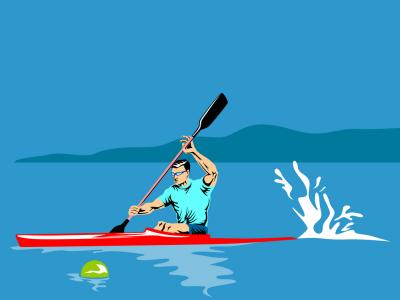Techniques for Better Paddle Control

Water sports attract the attention of daring and adventurous people. They experience great satisfaction and fulfillment in risking their lives. However, if played correctly with adherence to the rules, water sports turn out to be exciting and risk free. When you can enjoy a lot with a minimum amount of effort, you are on the right track.
Canoeing and kayaking make up the two major cold-water paddling sports carried out on calm as well as turbulent waters. It is not necessary for everyone to be an expert in this sport in order to participate. Proper clothing and training are the two basic things that make this sport enjoyable. Paddle control being the major aspect in kayaking and canoeing one must follow a few steps and use the proper methods to gain control of and manage the vessel.
The three main aspects that influence paddle control are – body position, hand position and the type of stroke. The controls and positions make acquiring better control of your boat very easy when used correctly.
Hand Position
Place one of your hands on the top of the paddle for a wide stroke and the other on the lower one to gain control over each stroke. The ability to manage the movement of the boat depends upon the grip you use; the wider the grip, the greater the power. The power of the strokes need not be the same on all waters. You have to decide how much stroke power to use based on the speed and nature of the water. The best position while paddling is with your hands straight without bending your waist.
Body Position
Stability is the main aspect that you must concentrate on while canoeing or kayaking. Both body and hand positions together play a main role in this. You will only achieve balance with your hands on the blade and your knees at the midpoint of the canoe. Keep your body straight and stable while piloting the canoe. A steady canoe and constant strokes will keep you going straight forward, easily braving rough waters.
Strokes
Before starting any adventure on the vessel, gain proper training in strokes and safety features. First, learn the basic strokes to gain control over the canoe. As a first step, sit straight in front of the paddles. Bend a bit and stretch your arm that is on the blade. The other arm should move back letting your upper body rotate. Now slide the blade of the paddle into the water. Rotate your body while your draw the blade out of the water. Now repeat the same steps for the next stroke.
Power Stroke
As mentioned above, strokes are not the same on all waters. They have to be changed and as per the currents. For every ninth stroke, the “power stroke” is the stroke to use. This stroke is to balance and steer your boat in a straight line in case of any disturbances of the water. To make this stroke effective grasp the shaft of the paddle nearest the blade and apply the stroke steadily. Use the upper half of your body during the process.
Try different sweeps for better movement of your canoe. Sweep the blades forward and out to the sides of the canoe. Make the shape of a semicircle from bow to stern. In this process, you will be taking the canoe in the opposite direction. By carrying out the same step in the reverse direction, the vessel will move the other way. You can do a quick 90-degree turn using the power stroke followed by a reverse sweep.
For a smooth ride on your vessel, you must maintain balance, speed and momentum. Use the stern rudder method to change or adjust the direction of your canoe. This technique changes the course of the vessel, which is sometimes necessary. Use this stroke for a few seconds and then quickly return to the original stroke. Fix the blade of the rudder just behind the cockpit and have the forward thrust work against it.
To sum it up you can avoid mishaps and capsizing in severe currents by following the basic rules of kayaking and canoeing. Just remember the positions of the blades and maintain proper body posture in the water for a happy and secure kayaking adventure.
